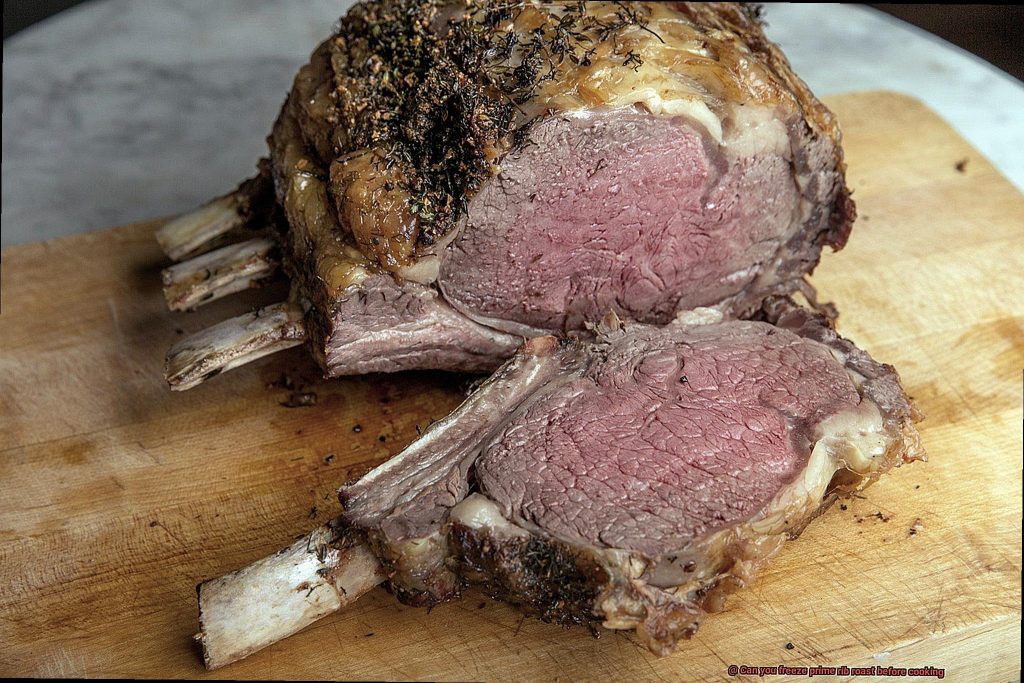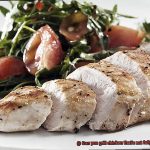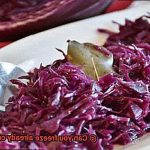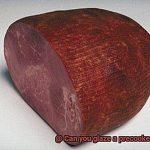Picture this: You’ve got a prime rib roast sitting in your fridge, waiting for that special occasion. But then life happens, and you’re forced to postpone the event. Or maybe you’ve stumbled upon a fantastic deal on prime rib roast, but you don’t want to cook it just yet. So, can you freeze prime rib roast before cooking? The answer is yes, but there are some things you need to keep in mind.
Freezing any kind of meat is an excellent way to extend its shelf life, and prime rib roast is no exception. When frozen correctly, it can last up to 12 months. That means you can enjoy a deliciously juicy and tender prime rib roast anytime you want. However, proper freezing techniques are crucial to ensure that your meat stays fresh and flavorful.
In this blog post, we’ll guide you through the process of freezing prime rib roast correctly. We’ll share some tips on packaging and thawing so that your meat retains its texture and taste after being cooked. So if you’re curious about how to freeze prime rib roast before cooking or have been wondering whether it’s even possible – keep reading.
Contents
Can You Freeze Prime Rib Roast Before Cooking?
If you’re wondering whether or not you can freeze your prime rib roast before cooking, the answer is yes. However, there are a few essential factors to consider to ensure the best results.
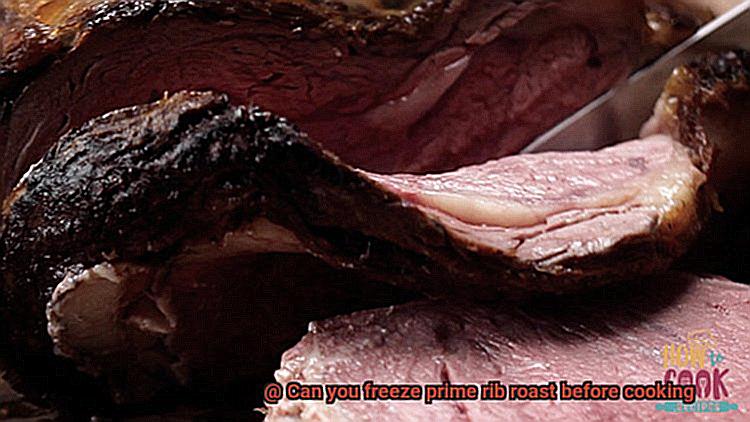
Firstly, freezing meat can affect its texture and taste. The freezing process causes ice crystals to form within the meat, which can damage the cell structure and lead to a tougher texture. Therefore, it is crucial to handle the meat properly before freezing.
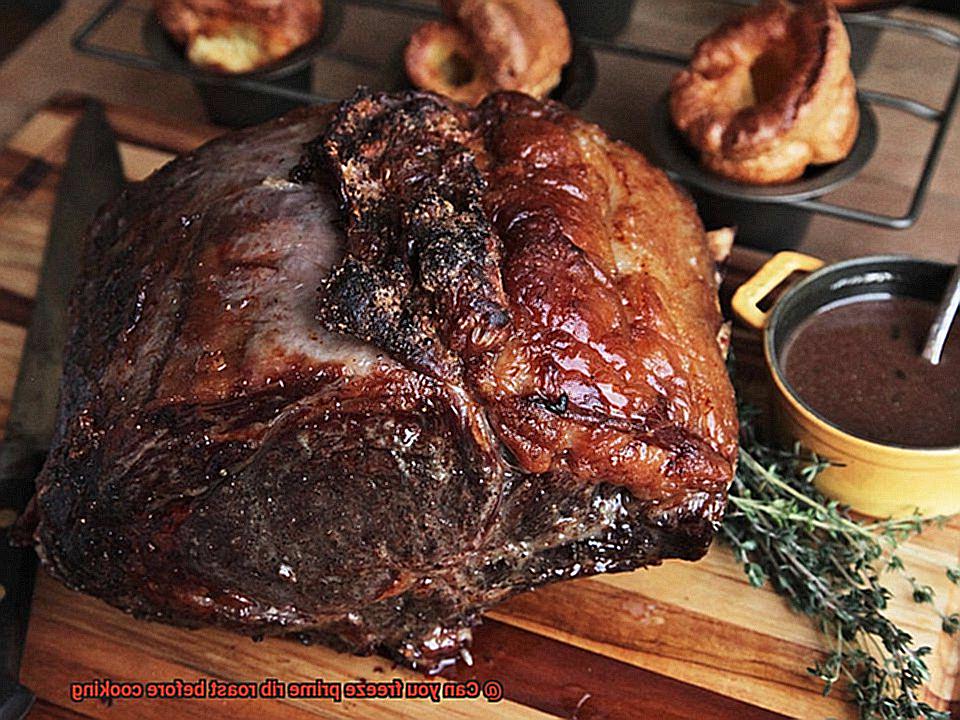
To freeze a prime rib roast, wrap it tightly in plastic wrap or aluminum foil to prevent freezer burn and air exposure. This will help preserve the quality of the meat. Additionally, placing the wrapped roast in a freezer-safe ziplock bag or container can offer extra protection and help keep it fresh for longer.
When it’s time to thaw your frozen prime rib roast, remember that slow and gentle thawing is key. The best method is to transfer the wrapped roast from the freezer to the refrigerator and allow it to thaw slowly over 24-48 hours. This will help preserve the texture and flavor of the meat.
In summary, here are the essential tips for freezing prime rib roast before cooking:
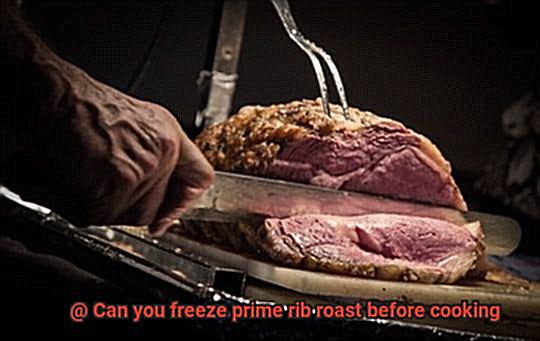
- Use fresh meat that has not been previously frozen.
- Wrap the meat tightly in plastic wrap or aluminum foil.
- Place the wrapped roast in a freezer-safe ziplock bag or container and label it with the date of freezing.
- Thaw the frozen prime rib roast slowly and carefully in the refrigerator.
The Benefits of Freezing Prime Rib Roast Before Cooking
As a prime rib roast connoisseur, I can attest to the fact that freezing your meat before cooking is a culinary game-changer. Not only does it lock in the delicious juices and flavors of your prime cut, but it also offers a host of other benefits.
One of the most significant advantages of freezing prime rib roast is its ability to preserve the quality of the meat. By keeping it fresh until you’re ready to cook, you’ll enjoy a more tender and flavorful end product that’s sure to delight your taste buds.
Additionally, freezing your prime rib roast allows you to plan ahead for special occasions or events. No more running to the grocery store at the last minute to find the perfect cut of meat. By purchasing and freezing your prime rib roast ahead of time, you can relax knowing you have a high-quality piece available when you need it.
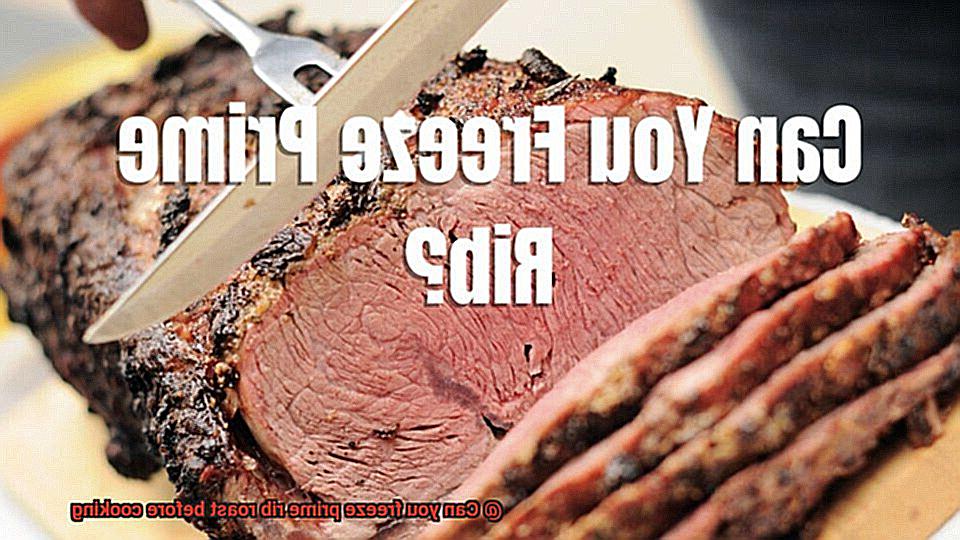
Moreover, freezing your prime rib roast makes portioning easier. You can thaw out just the right amount of meat you need for your dinner party instead of having to cook the entire thing at once. This way, you can save any leftovers for another meal or cut down on waste.
Lastly, freezing prime rib roast can even help you save money in the long run. When larger cuts of meat go on sale, buy them and freeze them for later use. This way, you can take advantage of lower prices and get more value for your money.
How to Properly Freeze Prime Rib Roast
Prime rib roast is a delicious cut of meat that is often served as a main course during special occasions or holiday dinners. However, sometimes you may be left with more than you can eat, and freezing the leftover prime rib roast is an excellent way to avoid wastage. Freezing your prime rib roast can also extend its shelf life and make it available for consumption at a later time. Here are some key steps to follow when properly freezing prime rib roast:
Choose a high-quality cut of meat
When selecting a prime rib roast for freezing, it is crucial to choose a fresh cut of meat that hasn’t been previously frozen. This ensures that the meat maintains its texture and flavor after being frozen.
Wrap and store the roast properly
Proper wrapping and storage of the prime rib roast before placing it in the freezer are essential to prevent freezer burn and other forms of damage. Wrap the roast tightly in plastic wrap or aluminum foil, making sure there are no air pockets, and then place it in a resealable plastic freezer bag.
Label the bag with the date and contents so you can easily keep track of how long it has been in the freezer. Store the roast in the coldest part of the freezer, such as the back or bottom shelf, at 0°F (-18°C) or lower.
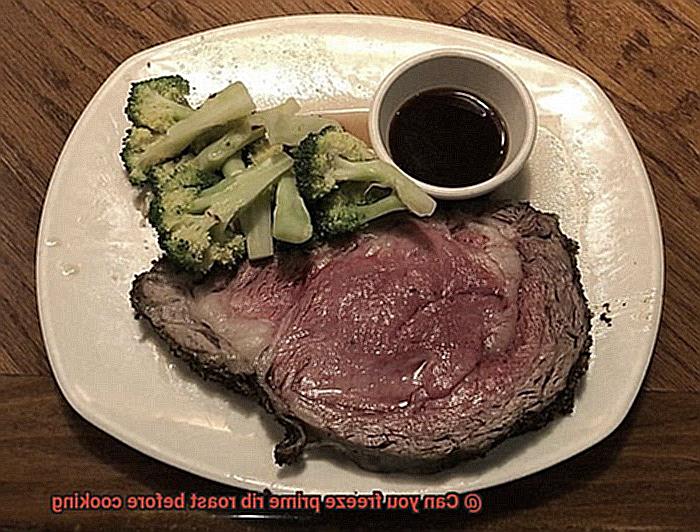
Freeze for up to 6 months
While freezing can extend the shelf life of meat, it will not improve its quality. Therefore, it’s recommended to only freeze prime rib roast for up to 6 months for best results. After this period, there might be changes in its flavor and texture.
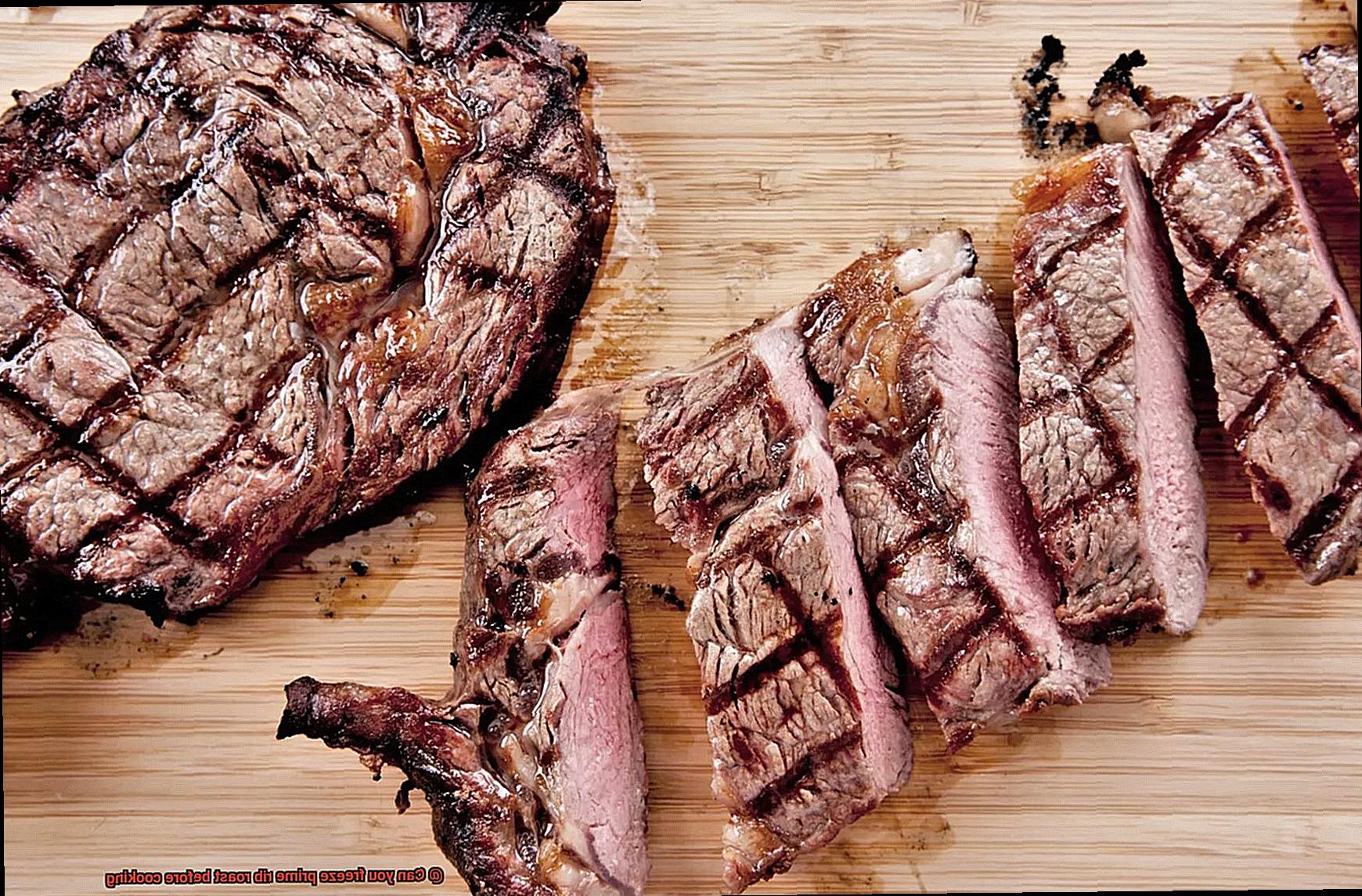
Thaw properly before cooking
Thawing is an essential step in preparing your frozen prime rib roast for cooking. The best method for thawing is to transfer it from the freezer to the refrigerator and allow it to thaw slowly over several hours or overnight. This ensures that the meat thaws evenly and remains at a safe temperature during the process. Avoid thawing your prime rib roast at room temperature or in hot water, as this can result in uneven thawing and bacterial growth.
Cook according to your preferred method
Once the roast is thawed, you can season it as desired and cook it according to your preferred method. Whether you choose to grill, bake, or roast your prime rib, be sure to use a meat thermometer to ensure that it reaches the appropriate internal temperature for safe consumption (usually around 135-140 degrees Fahrenheit for medium-rare).
Thawing the Frozen Prime Rib Roast
Before diving into the cooking process, it’s crucial to ensure that your frozen roast is thawed properly to retain its flavor and texture. As an expert in this field, I will share with you some tips on how to safely and efficiently thaw a frozen prime rib roast.
The most recommended method for thawing a frozen prime rib roast is to let it sit in the refrigerator for several days. The general rule of thumb is 24 hours for every 5 pounds of meat. So, if you have a 10-pound roast, it should be thawed for at least 48 hours or two days. Always remember to place the roast in a pan or on a plate to catch any juices that may leak during the thawing process.
But what if you’re short on time and need to thaw the roast quickly? The cold water method is your best bet. Simply place the frozen roast in a sealed plastic bag and submerge it in cold water. Change the water every 30 minutes until the roast is fully thawed. This method may take several hours, depending on the size of the roast.
However, it’s crucial to avoid using hot water or leaving the roast out at room temperature as this can promote bacterial growth and lead to foodborne illness. Always use caution when handling raw meat and follow proper food safety guidelines.
To summarize, here are some tips for thawing a frozen prime rib roast:
- Place the frozen roast in the refrigerator for several days.
- Use the general rule of thumb: 24 hours for every 5 pounds of meat.
- Place the roast in a pan or on a plate to catch any juices that may leak.
- Alternatively, use the cold water method by submerging the roast in cold water and changing the water every 30 minutes.
- Avoid using hot water or leaving the roast out at room temperature.
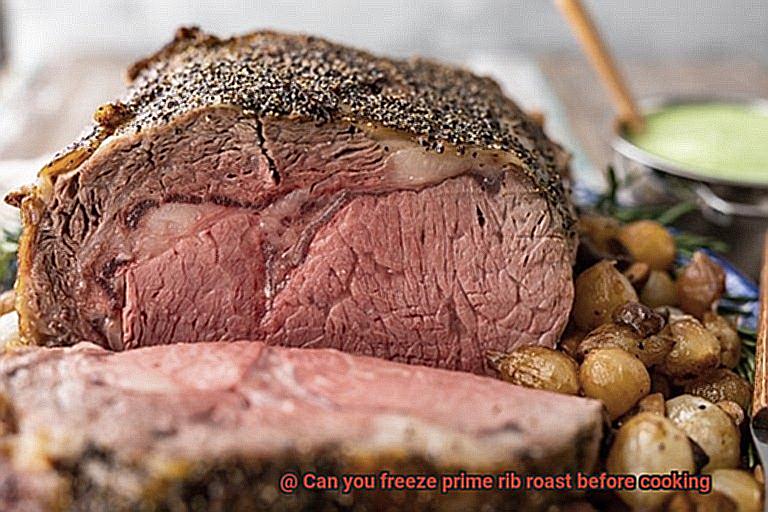
Tips for Preparing a Delicious Prime Rib Roast
As an expert in prime rib, I have compiled five essential steps for you to follow to ensure a mouth-watering roast that will have your guests coming back for more.
Choosing the Right Cut of Meat
To start, choosing the right cut of meat is crucial for preparing a delicious prime rib roast. Look for a prime-grade beef rib roast with good marbling. Marbling is the fat that runs through the meat, which gives it its flavor and tenderness. A nicely marbled roast will be juicy and tender after cooking, while a less marbled one will be dry and tough.
Preparing the Roast Before Cooking
Before cooking, allow the roast to come to room temperature for about an hour. This will ensure that the meat cooks evenly and retains its moisture. Season the roast generously with salt and pepper, and add additional herbs and spices for extra flavor. Some popular seasonings for prime rib include garlic, rosemary, and thyme.
Cooking the Roast
When it comes to cooking the roast, there are two key steps to follow. First, start with high heat to sear the outside and lock in the juices. Then, lower the heat to finish cooking the inside. Cook the roast for about 15 minutes at 450°F (232°C) per pound, then reduce the heat to 325°F (163°C) and continue cooking until the internal temperature reaches your desired level of doneness.
Resting Time
After cooking, let the roast rest for at least 15-20 minutes before carving. This allows the juices to redistribute throughout the meat, resulting in a more flavorful and tender final product.
Freezing and Thawing Tips
If you plan to freeze your prime rib roast before cooking, there are some additional tips to keep in mind. Make sure that it is wrapped tightly in plastic wrap or aluminum foil to prevent freezer burn. Thaw the meat slowly in the refrigerator, and allow it to come to room temperature before cooking. Use a meat thermometer to ensure that it reaches your desired internal temperature.
How to Reheat a Previously Frozen Prime Rib Roast
If you’re looking to reheat a previously frozen prime rib roast, it’s important to take certain precautions to ensure that the meat stays juicy and tender. In this article, we’ll provide some helpful tips on how to safely and effectively reheat your prime rib roast without compromising its flavor and texture.
Thawing the Roast
Before reheating your prime rib roast, make sure that it’s completely thawed. Proper thawing is essential to avoid bacterial growth and ensure that the meat is safe to eat. The best way to thaw a frozen prime rib roast is to place it in the refrigerator overnight. If you’re short on time, you can use the defrost setting on your microwave, but avoid using hot water or leaving it out at room temperature.
Reheating Methods
There are several methods that you can use to reheat your prime rib roast. Here are some of the most effective methods:
-
Low-Temperature Oven Method: Preheat your oven to 250°F and place the roast in a roasting pan with a rack. Cover the pan tightly with foil and heat until the internal temperature of the meat reaches 120°F, which should take about 30 minutes per pound. This method ensures that the meat is heated evenly without drying it out.
- Stovetop Method: If you’re short on time and want to reheat your prime rib roast quickly, slice it into thin pieces and heat them in a skillet with some beef broth or butter until they are warmed through. While this method may result in slightly drier meat than oven reheating, it’s still a great option for a quick and easy meal.
-
Sous Vide Method: If you have specialized equipment, sous vide reheating is an excellent choice for achieving precise temperature control and ensuring that your prime rib roast comes out tender and juicy. Vacuum-seal the sliced roast with some beef broth, and heat it in a water bath at 130°F for about an hour.
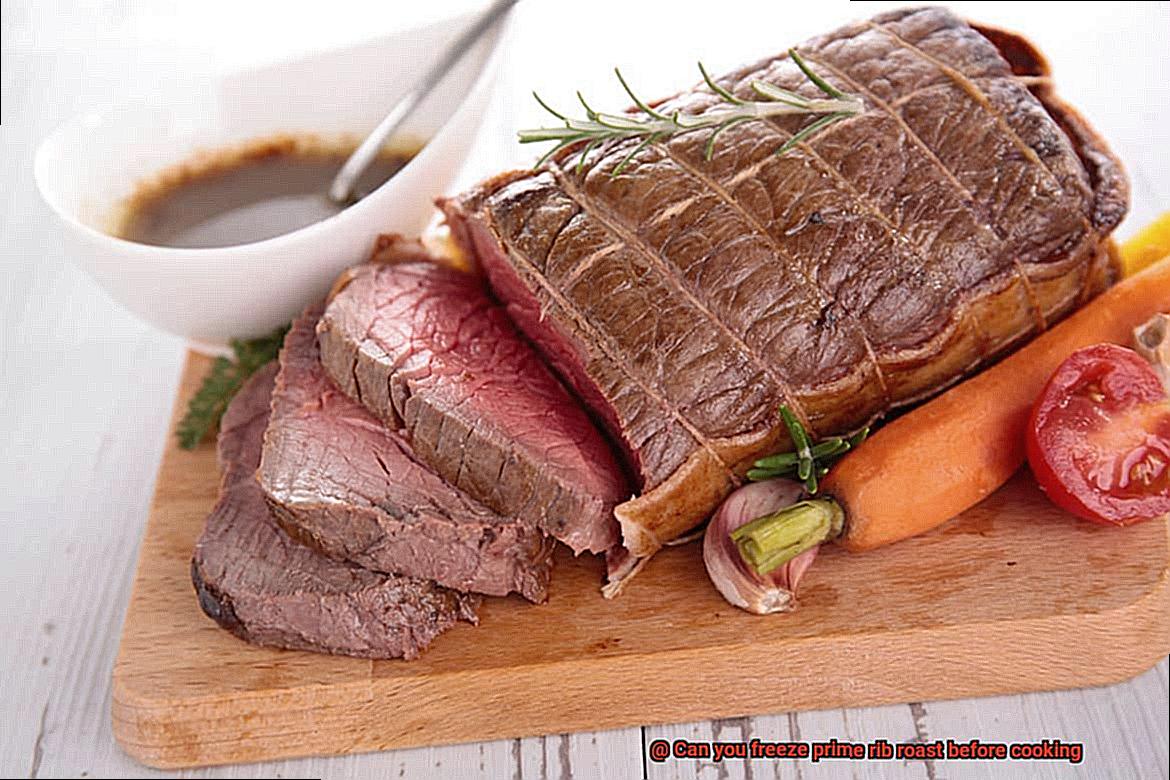
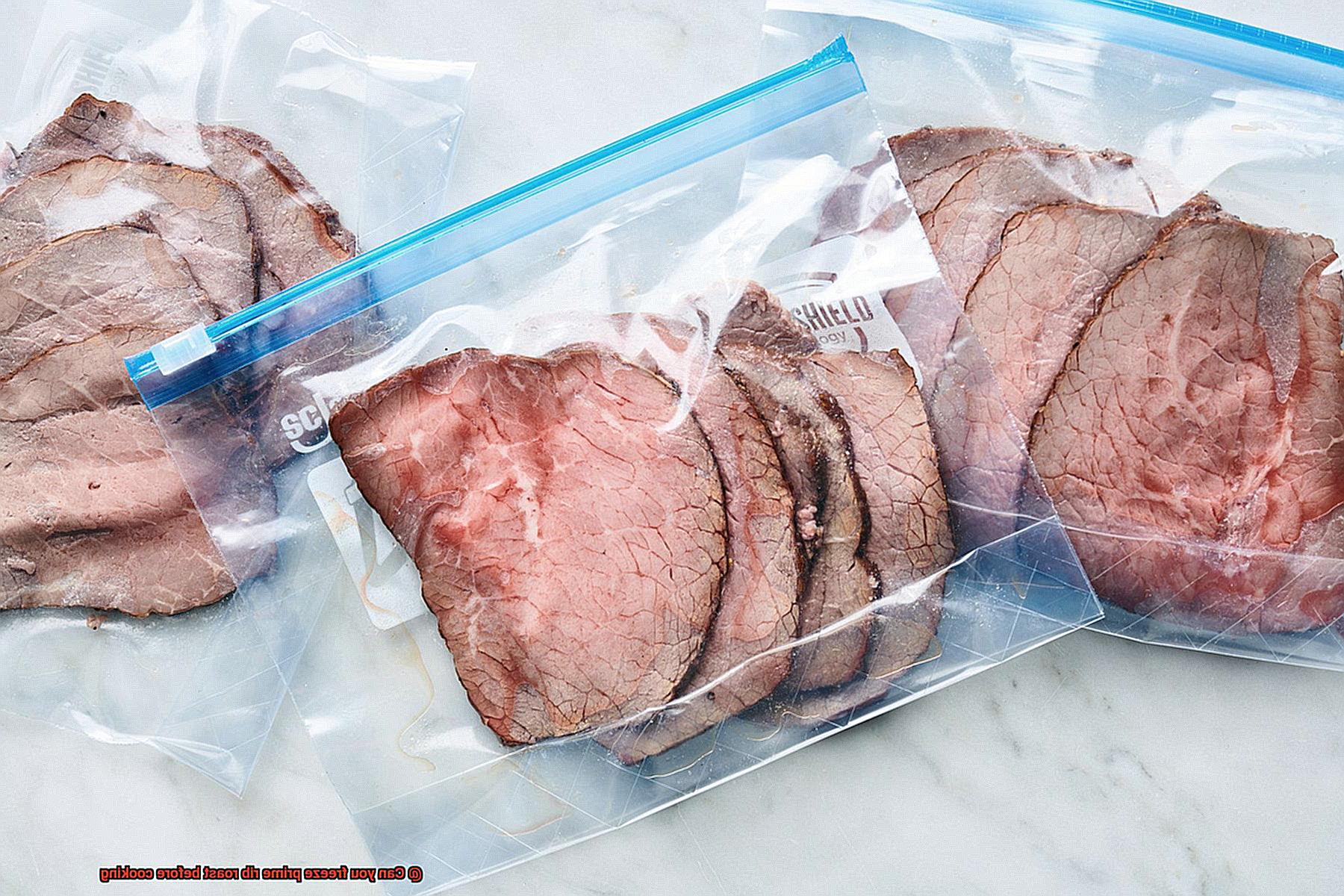
No matter which method you choose, make sure to use a meat thermometer to ensure that the roast is heated to the proper temperature without overcooking it.
Resting Time
After reheating your prime rib roast, let it rest for a few minutes before serving. This allows the juices to redistribute throughout the meat, resulting in a more flavorful and tender roast.
Common Mistakes When Freezing and Cooking Prime Rib Roast
Whether you’re a seasoned chef or a beginner, there are a few pitfalls to avoid when freezing and cooking this beloved cut of meat. As an expert in the field, I’m here to share some tips on how to achieve the perfect prime rib roast every time.
Firstly, it’s crucial to ensure that your prime rib roast is thoroughly thawed before cooking. This means taking it out of the freezer and allowing it to defrost completely in the refrigerator. Failing to do so will result in uneven cooking and portions of your meat being either undercooked or overcooked. Trust me, you don’t want to end up with a dry and tough prime rib roast.
Another common mistake is not seasoning your meat before freezing it. While it may seem easier to season your meat beforehand, using fresh herbs and spices rather than pre-made blends can make all the difference in the quality of your meat. I recommend seasoning your meat after thawing it, just before cooking it.
Overcooking your prime rib roast is another frequent error that can lead to disappointment at dinner time. It’s easy to assume that cooking your roast until it reaches a certain temperature is enough, but this can result in overcooked meat. Instead, invest in a meat thermometer and cook your roast until it reaches an internal temperature of 120-125°F for medium-rare or 130-135°F for medium.
Finally, resting your roast after cooking is crucial for optimal flavor and tenderness. Allowing it to sit for at least 15 minutes before carving and serving will ensure that the juices redistribute throughout the meat, resulting in a more succulent and flavorful roast.
lxLYSSDq5VY” >
Conclusion
In summary, the answer to whether you can freeze prime rib roast before cooking is a resounding yes. Not only does it extend its shelf life up to 12 months, but it also makes portioning easier and preserves the quality of the meat. However, proper freezing techniques are crucial for ensuring that your meat stays fresh and flavorful.
To freeze prime rib roast correctly, tightly wrap it in plastic wrap or aluminum foil to prevent freezer burn and air exposure. For added protection, place the wrapped roast in a freezer-safe ziplock bag or container. When thawing frozen prime rib roast, remember that slow and gentle thawing is key. Transfer it from the freezer to the refrigerator and allow it to thaw slowly over 24-48 hours.
Preparing a delicious prime rib roast involves choosing the right cut of meat, generously seasoning it before cooking with high heat followed by lower heat, and letting it rest for at least 15 minutes after cooking. Thawing your previously frozen prime rib roast properly using low-temperature oven method or stovetop method is important before reheating it. Avoid common mistakes such as not thoroughly thawing your meat before cooking or overcooking your prime rib roast.

